Key Findings
- According to HireAHelper data, 11.4% more people moved to Florida than left in 2023.
- In 2023, Wesley Chapel, FL (+106%) and Ocala, FL (+104%) had the highest net gain of new residents
- The Miami, FL metro area had the highest net losses (-58%) in terms of moving
- Ten times more people left Florida in 2023 for “change of climate” (≈43,000 people) than moved there for the same reason (≈3,700)
- Retirement accounted for 8% of those moving to Florida in 2023
- New Florida residents (average age 43) are, on average, 10 years older than Americans leaving Florida (average age 33)
In an episode of Seinfeld titled The Pony Remark, the eponymous character says, “My parents didn’t want to move to Florida, but they turned sixty and that’s the law.” Airing in 1991, the quote from this episode reflected a broader truth that many Americans were moving to Florida in droves during that time — especially New Yorkers
While Florida does have a history of being a retirement magnet that goes back to the 1910s, looking at migration to The Sunshine State through the lens of retirement moves would be reductive. As many as 4.3 million people moved to Florida from other U.S. states in the 1990s. Based on Census Bureau figures, for nine of 10 years of that decade, Florida was the #1 state Americans moved to.
“‘New job or transfer’…was by far the most common reason for moves bound for the Sunshine State, accounting for over half (~54%) of all moves to Florida in 2023.”
In this study, we delve into the migration trends shaping Florida today. Using a mixture of the U.S. Census and HireAHelper data, we explore moves to, from, and within Florida, and see which cities attract the most residents. We also outline the typical demographics of Florida movers, highlight the top reasons for people moving to or from Florida, and show how both have changed over time.
Southbound and Down: Three Decades of Migration to Florida
In the last 10 years alone, Florida welcomed 3.4 million Americans as new residents. That’s roughly the population of the whole state of Utah! Of those, more than a third (1.2 million) moved to the Sunshine State since 2020, according to the Census Bureau’s statistics.
And it shows. As per the latest population statistics available, two-thirds (66%) of Floridians were born elsewhere in the United States, which is second only to Nevada (74%).
For a state that’s as large as Florida, it’s rather common to see this high volume of moves. What’s more remarkable is Florida’s net migration numbers remain positive. Meaning, that more people continue to move to the Sunshine State than leave it.
According to HireAHelper estimates, approximately 11% more Americans moved to Florida than left in 2023, with an average of 13% net gain in residents in the last six years (which is as far back as our records go).
Along U.S. 1: Top Origins States to Florida are on the East Coast
And which states supplied all these new Florida residents? Migration to Florida used to be heavily dominated by New York, which was, according to the Census Bureau data, the #1 origin for moves going to Florida between 1990 and 2010.
In the last decade, Connecticut, Massachusetts, and Ohio have featured prominently on the list of states sending most people to the Sunshine State. Most recently, though, the top spot belonged to Georgia. In 2023, around 87,000 people moved from Georgia to Florida, which represented a quarter of all interstate moves destined for the Sunshine State in 2023.
| State | % of moves to Florida |
| Georgia | 23.3% |
| New York | 20.5% |
| Maryland | 15.8% |
| Ohio | 10.0% |
| Texas | 9.4% |
| New Jersey | 6.5% |
| Virginia | 3.1% |
| North Carolina | 2.7% |
| Arkansas | 2.3% |
| Arizona | 1.7% |
Other states that contributed the most new residents to the Florida population in 2023 include New York (~21%), Maryland (~16%), and Ohio (10%).
To see how many people moved to Florida from your state, check out our interactive map below. You can also use the drop-down to go back in time and see how that’s changed over the years.
Jobs, Retirement, and Housing: Top Reasons for Moving to Florida
Many may associate moves to Florida with retirement, but the overwhelming majority of people heading to this state are doing it for job-related reasons.
“New job or transfer”, as the U.S. Census Bureau calls it, was by far the most common reason for moves bound for the Sunshine State, accounting for over half (~54%) of all moves to Florida in 2023.
Buying a home was the second most common reason for Americans relocating to Florida, with around 12% of all newly arrived Florida residents in 2023 making a move.
And then, there’s retirement – a reason responsible for 8% of all moves Americans made to Florida last year.
Buying a home in Florida and moving there is a fairly recent trend. A historic high of 20% of moves to Florida in 2022 were made for this reason, but it was never this common further in the past.
Conversely, “change of climate” declined as a reason for moving to Florida in recent times. Remember that to the Census Bureau, “change of climate” can mean either escaping the consequence of climate change (like flooding or hurricanes) or wanting more sunshine.
Accounting for roughly 10% of moves in any given year before 2020, less than 6% of people moving to Florida in the last three years did it because of the weather.
Move Over, Miami: Most Florida-Bound Moves Are Destined for the Gulf Coast
So with all those people moving to Florida, where are they choosing to live? In 2023, nearly half (48%) of all newcomers to Florida went to one of the following metro areas: Sarasota, FL (~24%), Tampa, FL (~13%) and Miami, FL (~12%).
Those familiar with Florida’s geography should notice that Sarasota, FL and Tampa, FL are on the Gulf Coast, as are five more metros that made the top 10 moved-to cities in the state.
Not only were Gulf Coast destinations most popular in 2023, but they also showed significant growth in the number of moves they attracted.
Sarasota, FL had 45% more moves in 2023 than the year before, while Tampa, FL registered a 53% annual growth in inbound moves over the same period. Pensacola, FL had 13% more out-of-staters move in 2023, while Naples, FL received twice as many new residents from outside Florida, compared to 2022.
Curiously, even though the Miami metro area did make the top 3 destinations for out-of-state moves to Florida, its appeal appears to be declining. The city’s 9% year-over-year decrease in the number of new residents from other states in 2023 followed a more precipitous drop of 33% in the year prior.
See prices for local moving labor. Read real customer reviews. Easily book your help online.
Cheaper, Safer, Quieter: More Floridians Move to Smaller, Inland Cities
Despite a significant number of people moving to Florida from other parts of the U.S., the overwhelming majority of moves these days are local. The latest Census Bureau statistics showed that 54% of those moving stayed within the same county, while our data showed that the average distance of a move in 2023 was 32 miles.
Based on data from HireAHelper moves in Florida, the two cities that saw the greatest net inflow of new residents in 2023 are Wesley Chapel, FL (+106%) and Ocala, FL (+104%).
“In 2023, the average household income of those moving to the Sunshine State was $104,000. Not only is it significantly higher than the national average of $74,580, but it is also 44% higher than the income of those leaving Florida…”
Other cities that had more people move in than leave include St. Augustine, FL (58%), The Villages, FL (+50%), Pensacola, FL (+49%), and Port St. Lucie, FL (+48%).
One trend likely impacting moves within Florida is extreme weather, as some Floridians flock inland to places like Ocala and The Villages to escape the hurricanes and the associated high home insurance costs in coastal areas. Nowhere in Florida is completely safe from a hurricane, but it seems moving away from certain coastal areas may be relatively safer.
Another consideration for moving decisions is traffic congestion and the high cost of living in Florida’s larger metros. These issues may be behind people’s moves to more suburban areas, such as Bradenton, FL or Port St. Lucie, FL.
| 10 Cities with Largest Net Gains | Net Moves, % | 10 Cities with Largest Net Losses | Net Moves, % | |
| Wesley Chapel, FL | 106% | Hollywood, FL | -58% | |
| Ocala, FL | 104% | Fort Lauderdale, FL | -50% | |
| St. Augustine, FL | 58% | Palm Harbor, FL | -42% | |
| The Villages, FL | 50% | Miami, FL | -38% | |
| Pensacola, FL | 49% | Cape Coral, FL | -37% | |
| Port St. Lucie, FL | 48% | West Palm Beach, FL | -35% | |
| Gainesville, FL | 44% | Tampa, FL | -34% | |
| Clermont, FL | 43% | Fort Myers, FL | -31% | |
| Port Orange, FL | 27% | Orlando, FL | -31% | |
| Daytona Beach, FL | 23% | Pompano Beach, FL | -28% |
In contrast, cities that had lost the most residents are Hollywood, FL (where 58% more people left than moved in), Fort Lauderdale, FL (-50%), and Palm Harbor, FL (-42%). Miami, FL wasn’t too far off with 38% more outbound than inbound moves in 2023.
Local reports suggest that the high cost of housing could be what’s driving moves out of cities in Miami-Dade County. Home prices reached up to 50% higher and rents were 30% higher in this area, compared to other places in Florida.
Our interactive map shows how other cities have fared in terms of people moving in and out in 2023, based on HireAHelper data.
Ocala for Cheaper Housing, Melbourne for Retirement: Moves to Florida Cities by Reason
If we look at why people are moving to different cities in Florida, a few interesting patterns begin to emerge.
According to our analysis of the Census Bureau data, 57% of people who moved to Ocala, FL did so because they bought a home there. New jobs were the main driver of moves to Naples, FL (58%) and Bradenton, FL (38%), while those moving to Port Saint Lucie, FL did so predominantly because they wanted a better home (41%) or a better neighborhood (36%).
Two cities on Florida’s Atlantic coast, Palm Bay, FL and Melbourne, FL, had around 40% of people moving there for retirement.
Finally, cheaper housing greatly contributed to those moving to Lakeland, FL (32%) and Naples, FL (30%).
But with some of the highest home prices in the state, Naples, FL being a destination “for cheaper housing” is surprising. Its status as a top 10 contender for those moving into Florida from other states might explain this discrepancy.
Older, Higher in Income, Mostly White: Demographics of Americans Moving to Florida
According to the figures from the Census Bureau, Americans moving to Florida were, on average, 43 years old and over half of them (53%) were women. Generationally, 56% of them are either Gen X (30%) or Baby Boomers (26%).
While 43% of newcomers to Florida were married, almost one in five (19%) were divorcees, which was the 4th highest proportion among all states.
From a racial standpoint, 75% of those moving to Florida were white, which was significantly higher than the 60% of white Americans among interstate movers nationally.
40% of Americans opting to move to Florida have a college degree (undergraduate or postgraduate), which was only slightly lower than the average of 43% of interstate movers nationally in 2023.
Looking at the demographics of people moving in and out of Florida, income is one characteristic that stands out. In 2023, the average household income of those moving to the Sunshine State was $104,000. Not only is it significantly higher than the national average of $74,580, but it is also 44% higher than the income of those leaving Florida ($72,427 on average).
This 44% difference between the incomes of those moving in and those moving out was the also highest it has been in over 30 years.
See prices for local moving labor. Read real customer reviews. Easily book your help online.
Younger, Mostly Single, Mostly People of Color: Demographics of Those Leaving Florida
With an average age of 33.5, two-thirds (67%) of Floridians who left the state in 2023 are either Millennials (36%) or Gen Z (31%).
Unlike those moving in, the majority (54%) of people who left Florida last year are people of color, with roughly equal shares of black (24%) and Hispanic Americans (24%).
When it comes to their marital status, 53% of former Florida residents choosing to move elsewhere are single. It must be noted that the Census Bureau’s definition of “single” includes cohabiting couples that aren’t married in the legal sense of the word.
As noted above, those leaving Florida earn significantly less than those moving in.
Jobs, Family, and Climate: Top Reasons for Leaving Florida
Speaking of leaving Florida, over 285,000 Americans left the Sunshine State in 2023. The most common reason for such a move was a new job (37%).
The second most stated reason for leaving Florida is the “other family” reason (16%), which the Census Bureau defines as moving in with or closer to family members.
The third most popular one — “change of climate” — was responsible for 15% of all moves out of Florida last year.
As stated earlier, the reason encompasses both those who move in search of better weather and those who move to escape climate change. What’s remarkable about this statistic is that in 2023, ten times as many people left Florida for climate-related reasons (≈43,000) than moved in (≈3,700).
Since the Census Bureau has started tracking reasons for moving in their Current Population Survey, the number of Americans leaving Florida for climate-related reasons has never outnumbered those moving into the state — until 2021.
Due to the ambiguous definition of this reason for moving, it’s impossible to say with 100% certainty that all those who left Florida for climate reasons were escaping climate change.
However, hurricanes in the state have been getting stronger and more devastating, and the temperatures are growing increasingly higher, especially in the southern parts of the state.
Cost, Size, Distance: Industry Stats on Florida Moving
For all the moving in, out, and within Florida, it remained one of the cheapest states in terms of moving costs.
The average price of a move was $390 in 2023, making Florida the 9th cheapest state for moving. Moving prices held surprisingly steady and only grew 4% in the last year, up from $375 in 2022.
“Migration to Florida used to be heavily dominated by New York, which was, according to the Census Bureau data, the #1 origin for moves going to Florida between 1990 and 2010.”
Much like in the rest of the US, the distances of moves in Florida decreased. With spikes up to 70 miles on average in the pandemic years, the average move distance in Florida in 2023 was 31.5 miles.
The average size of homes people are moving into and out of in Florida is 1,546 square feet. That is just under the typical size of a home in the Sunshine State, which is 1,694 square feet.
Sources and Methodology
HireAHelper’s Florida Migration Study used the following data sources:
-
local and long-distance moves in Florida that were booked in 2023 through HireAHelper.com and its partner sites and affiliates
-
Migration/Geographic Mobility Data series by the U.S. Census Bureau
-
U.S. Census Bureau’s Current Population Survey and its Annual Social and Economic Supplements, as available via IPUMS
Net gains and losses in people moving in/out for both states and cities were calculated as the ratio of:
-
# of people moving into the state or city, to
-
the # of people moving out of the state or city,
-
expressed as a percentage (%)


 But while the search interest in moving abroad is waning, the number of U.S. citizens moving to some of the top destination countries in 2023 is increasing year-over-year.
But while the search interest in moving abroad is waning, the number of U.S. citizens moving to some of the top destination countries in 2023 is increasing year-over-year. Based on HireAHelper figures for the first five months of 2023,
Based on HireAHelper figures for the first five months of 2023, 
 It’s sensible for corporations to seek better fiscal conditions for their business. But what about the employees that get caught up in corporate relocations and transfers?
It’s sensible for corporations to seek better fiscal conditions for their business. But what about the employees that get caught up in corporate relocations and transfers?





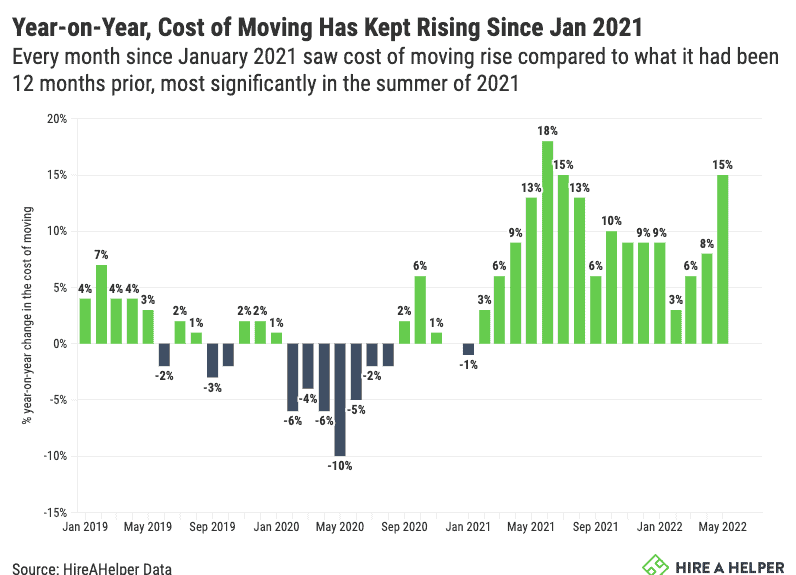

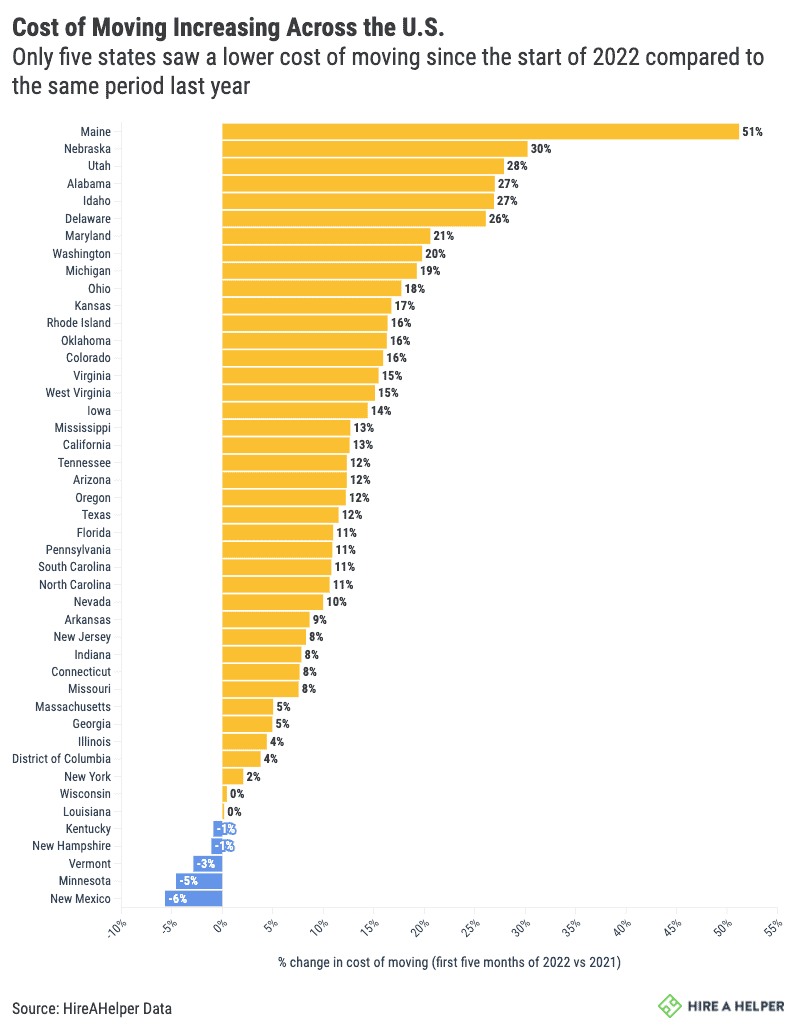
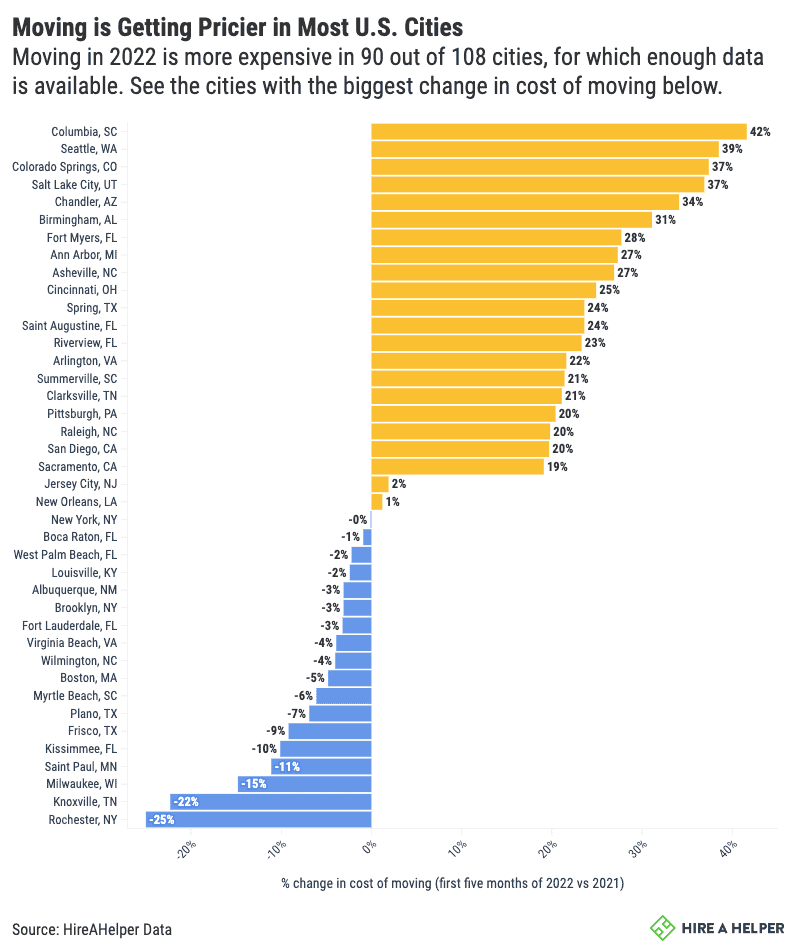
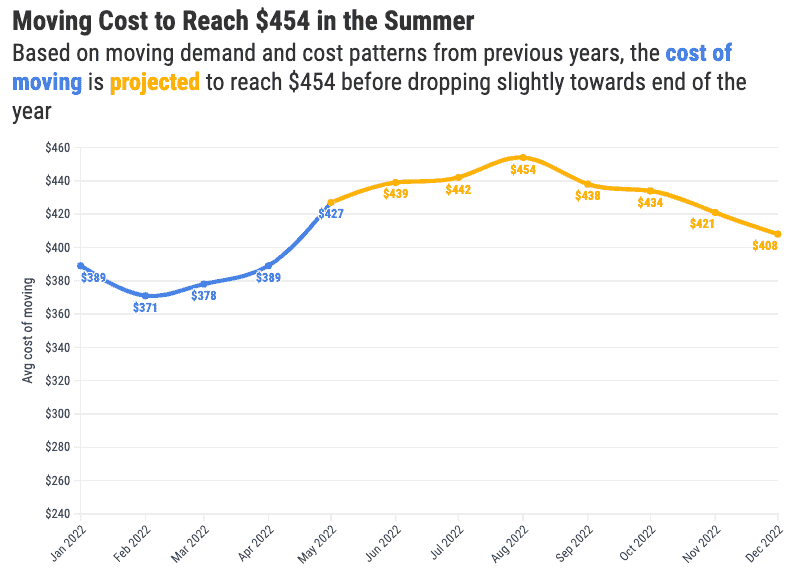
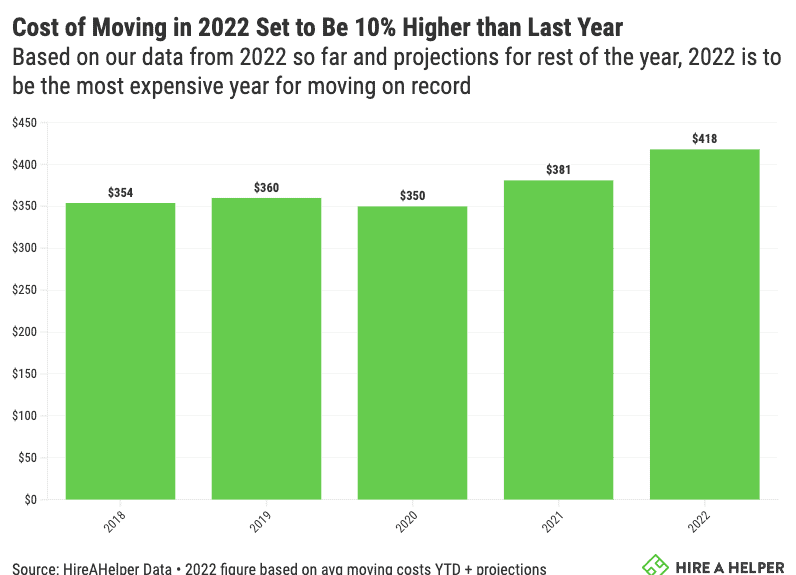
 When we look at where people who moved for love ended up, there are some big differences between states.
When we look at where people who moved for love ended up, there are some big differences between states.

 Contrary to popular belief, not everything’s more expensive in SoCal versus NorCal. When comparing the cost of moving in Northern California versus Southern California, there’s virtually no statistical difference. Moving labor costs are roughly $443 in both regions, on average.
Contrary to popular belief, not everything’s more expensive in SoCal versus NorCal. When comparing the cost of moving in Northern California versus Southern California, there’s virtually no statistical difference. Moving labor costs are roughly $443 in both regions, on average.